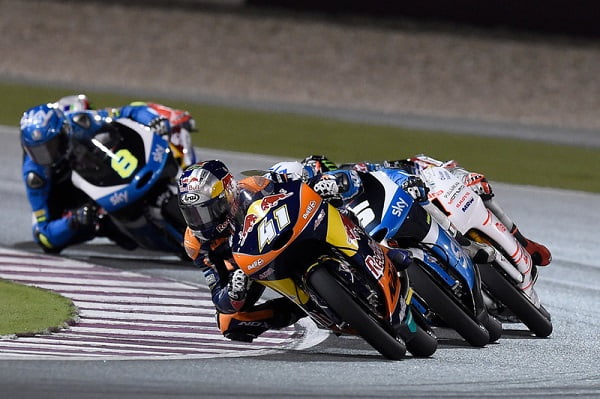To change partners, you need a reason. To keep the same, it is not necessary. It is according to this principle that the Austrian manufacturer, reigning Moto3 World Champion with Brad Binder, decided to build a pyramid system to provide the best riders to its MotoGP team.
The principle of this vertical integration is based on four successive categories, with detection at international level and the first good level comparison carried out during the Red Bull Rookies Cup. This then makes it possible to select the best elements to allow them to continue their career always with KTM, but this time at the higher level with the Moto3 World Championship. Until now, the collaboration with the young hopeful stopped there, due to a lack of Austrian material available in the higher categories. It will now be different in 2017, with the arrival of KTM in MotoGP, but also in Moto2 to make the connection, despite the disadvantage of using a Honda engine. How does the company Kpurrif & Trunkenpolz Mattighofen has she reached this unique situation?

First GP victory with Casey Stoner
For context, KTM was founded in 1934 and built its reputation in off-road racing, winning its first 250 motocross title in 1974 with the talented but penniless Soviet Gennady Moisseev. It was only 30 years later that the brand made its appearance in GP 125 in 2003, then in GP 250 in 2005, and in MotoGP in 2005 with Team Roberts, although the official hagiography of KTM prefers to forget this episode . The first Grand Prix won on tarmac was won by a young Australian named Casey Stoner, on October 10, 2004 at Sepang in 125. It was all the more impressive as KTM had only been competing in Grand Prix the previous year. , and that Stoner had the only KTM on the grid in Malaysia. In 2012 Sandro Cortese won the firm's first world title in Moto 3, imitated by Maverick Vinales the following year, and Brad Binder in 2016.

Moto2, intermediate level
KTM has just launched into Moto2 with its WP brand, under the leadership of loyal Aki Ajo. Only the chassis part is in-house, including the Honda 600 CBR engine prepared at ExternPro. Manufacturers – including KTM – are not fighting to replace Honda as the exclusive supplier of Moto2 power units. The choice of solidity was made by Dorna, and very few motors broke during two million kilometers carried out since the creation of the category. The other side of the coin is, for example, that when spectators see the Moto2 in a straight line just after the MotoGP, since this is the order in which these two categories appear on stage on Friday and Saturday, they are struck by the anemia of the 600: the speed of Andrea Iannone's Ducati was 351,2 km/h during the Qatar GP in 2016, compared to 286,7 for the fastest in Moto2, Robin Mulhauser. At Mugello, Iannone with 354,9 km/h was facing Marquez's 292, a record set in 2012. At Le Mans, where it climbs in the pit straight, Iannone with 316 flattened Alex Rins and his 263. The differences were so enormous, and the image of the engines less than 130 horsepower so lackluster, that KTM, after having considered offering twin-cylinders for a while, focused on producing a cycle part.

Tomorrow on this site, the rest: MotoGP and trends
KTM photos, credits Focus Pollution, Sebas Romero, M. Campelli and Philip Platzer



